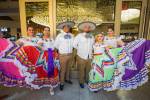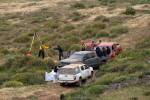‘Bittersweet Harvest’ explores largest Mexican guest-worker program in U.S. history
If you think the debate over Mexicans crossing the border to work in the U.S. sounds like a ripped-from-the-headlines issue, think again.
Or visit the Springs Preserve's Big Springs Gallery for an eye-opening history lesson in "Bittersweet Harvest: The Bracero Program, 1942-1964."
The bilingual exhibition, created by the National Museum of American History, explores what became the largest Mexican guest-worker program in U.S. history - from the opportunities it offered to the exploitation many participants endured.
Launched in 1942, when American farmworkers were fighting World War II, the bracero program was designed to solve the labor shortage by bringing Mexican workers to U.S. farms. (Some braceros also worked on U.S. railroads.)
As President Franklin D. Roosevelt put it during a 1943 visit to Monterrey , Mexico, "Mexican farmworkers ... are contributing their skill and their toil to the production of vitally needed food" during the war years.
Even after World War II ended, however, the bracero program continued. During its 22-year existence, an estimated 2 million Mexican workers came to 34 U.S. states - including Nevada - on short-term labor contracts.
In evocative photographs and oral-history excerpts, "Bittersweet Harvest" traces the path Mexican workers traveled to become guest workers in the U.S. - and details their experiences once they crossed the border.
"Oh, welcome to California," 1960s protest singer Phil Ochs wrote of the process in his 1960s song "Bracero," describing a place "where the friendly farmers will take care of you, and the sun will bite your body as the dust will draw you thirsty, while your muscles beg for mercy."
The bracero exhibit's details may be news to many Springs Preserve visitors, but they provide a vivid reminder to Southern Nevadans with a personal connection to the program.
Locals such as Roberto Alvizo , a real estate agent whose father worked as a bracero in the early '50s, harvesting crops in California and Texas.
Alvizo coordinates a local group of about a hundred former braceros, and their families, who meet monthly.
The history explored in "Bittersweet Harvest" is personal, and sometimes painful, for them, Alvizo says.
Alvizo's father "used to tell stories of a lot of terrible things" he experienced during more than a decade as a bracero, from being stripped and sprayed with the pesticide DDT before he could enter the U.S. (a practice shown in one of the exhibit's photographs) to paycheck deductions, a dime from every dollar earned, for retirement benefits that remain in legal limbo, Alvizo says.
"It was like slavery" is how Alvizo's father described his work to his son.
Often, braceros were so busy working they would be "eating with one hand and picking oranges with the other," according to Alvizo.
Despite the harsh conditions, the chance to earn money for his family in Mexico kept Alvizo's father returning to the job, year after year.
Photographs featured in "Bittersweet Harvest" document the braceros' journey from Mexico to the U.S. - and onto the farms. One photograph depicts a bracero washing his clothes in an outdoor stream. Another shows a bracero dormitory with double-decker metal cots.
("When the weary night embraces, sleep in shacks that could be cages - they will take it from your wages," Ochs sang in "Bracero.")
In one display panel, former bracero Aurelio Pereida Rodarte recalls how "no one let me sleep" on Saturdays, because "everyone wanted their hair cut so they could go to the movies ... in town they charged a dollar, and I charged 50 cents" - an important consideration for workers making 50 cents an hour.
"Bittersweet Harvest" also addresses the labor strife that accompanied the bracero program, including a 1961 lettuce strike in California's Imperial Valley. (One photograph shows a protester holding a sign, "Braceros are strikebreaking in the Imperial Valley.")
An oral-history station enables visitors to hear a dozen participants comment on their experiences, from a clerk-typist at a Texas border processing station to a Colorado farmer who praised the braceros' work ethic and expressed his wish that "the houses had been nicer" and "the pay had been higher."
Booked more than two years ago, "Bittersweet Harvest" is the first Springs Preserve exhibit organized by the Smithsonian Institution Traveling Exhibition Service, according to assistant curator Jessica Hougen .
For former braceros (and their families) who attended the exhibit's opening reception, "it meant a lot to them to see something chronicling" their experiences, she notes.
And with ongoing debate regarding Mexican workers in the U.S., the exhibits focus is "very pertinent right now," Hougen says.
The preserve's Big Springs Gallery generally hosts exhibits by local artists, she notes.
But "every once in a blue moon we come across" an informational exhibit "that's a really good fit," Hougen explains. "This is one of those times."
Contact reporter Carol Cling at ccling@reviewjournal.com or 702-383-0272.
Preview
What: "Bittersweet Harvest: The Bracero Program, 1942-1964"
When: 10 a.m.-6 p.m. daily through July 29
Where: Big Springs Gallery, Springs Preserve, 333 S. Valley View Blvd.
Tickets: Included with general admission, $4.95-$9.95 for Nevada residents, $8.95-$18.95 for nonresidents (822-7700, springspreserve.org)




























